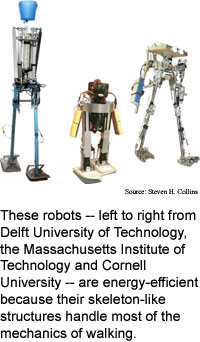
The key is a line of technology called passive-dynamic walking, which uses gravity to drive a bipedal device down a slope. Passive-dynamic technology does not attempt to control all joints in the movement, but allows most of the joints to hang free.
The robots developed by the three universities solve a variety of other problems related to balance, stride, foot size, stopping, steering, shock absorption and even walking backward. In addition to use in humanoid robotics, the research shows promise in helping to develop better prosthetic legs and feet. However, practical applications are likely at least 20 years out.
Source: Technology Research News
robotics
No comments:
Post a Comment